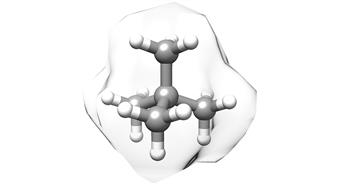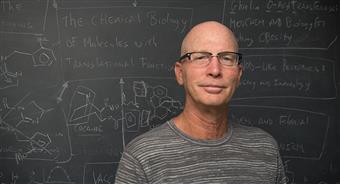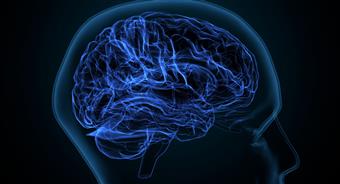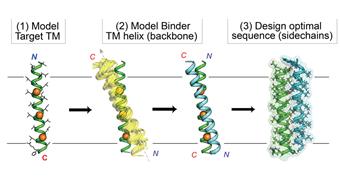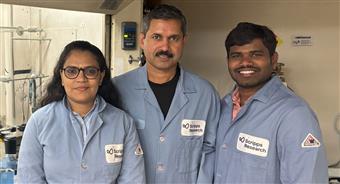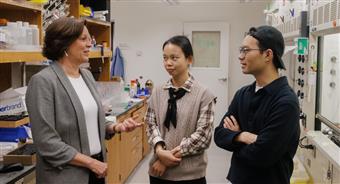
A new kind of molecular differentness Chemists' discovery of a small bacterial molecule with natural and inside-out' versions could have implications for future drug development
January 02, 2020
LA JOLLA, CA Chemists at Scripps Research have found a new way in which small organic molecules, despite having the same chemical formula and all the same chemical bonds, can differ in shape and therefore in their biological properties.
The chemists, who report their discovery in a paper in Science, found that a mysterious molecule called tryptorubin A, which is made only by certain bacteria that live in ant colonies, can be synthesized in the natural form or in a strange-looking alternative form that is essentially inside out.
This unusual type of shape variation, called non-canonical atropisomerism, has never been observed in a small molecule before. Small molecules are of special interest for chemists because most drugs are made of them their small size allows them to survive the digestion process when in pill form.
The ways in which a small molecule can vary in shape when it is synthesized are important too because often only one shape variant, or isomer, has the desired biological activity.
The Scripps Research chemists in this case were able to devise a technique to synthesize either the natural form of tryptorubin A or the unnatural, inside-out isomer.
I think our new awareness of this complex isomerism that can occur in small molecules, and the possible necessity of driving a synthesis towards one isomer or the other, are ultimately going to be relevant to the development of new drugs, says study lead author Solomon Reisberg, a graduate student in the laboratory of Phil Baran, PhD, the Darlene Shiley Chair in Chemistry at Scripps Research.
The study was a collaboration between the Baran Laboratory and the laboratory of chemist Jon Clardy, PhD, a professor of biological chemistry and molecular pharmacology at Harvard Medical School. Clardy and his colleagues isolated tryptorubin A in 2017 in the course of studying the symbiosis among ants, the fungus they farm for food, and the bacterial species that live on the fungus. The newly discovered compound, which has an oddly globular shape despite its small size, is produced by at least one species of fungus-associated Streptomyces bacteria.
No one yet understands tryptorubin A's natural function, Reisberg says. All that's known for sure is that it is found only when all three species ants, fungus, bacteria are around, so possibly it has a signaling role.
For the Baran lab, which specializes in finding new ways to make small molecules, tryptorubin A posed a more direct challenge: how to develop a set of organic chemistry reactions to make this natural compound with its highly strained, spherical, cage-like shape.
They eventually found a method to do that, but in analyzing the product they discovered that it existed in two alternative shapes, which they eventually recognized as roughly right side in and inside out. That type of isomerism has been considered impossible except in larger molecules that can fold into complex shapes with much less strain.
The discovery posed a new challenge: how to synthesize just the natural isomer of tryptorubin A, or alternatively the inside-out isomer. The solution that Reisberg and colleagues devised was to install a cluster of chemical bonds at the start of the synthetic process so as to force the structure to bend in one way or the other and then remove that guiding element once the structure closed on itself.
As chemists our job is to control the shapes of molecules in ever more sensitive ways to make better drugs and other products, Reisberg says. Here, we've shown that we can do that in a complex and unexpected context that may be pertinent for the development of some future drugs.
Total synthesis reveals atypical atropisomerism in a small-molecule natural product, tryptorubin A was written by Solomon Reisberg, Yang Gao, and Phil Baran, of Scripps Research; and Allison Walker, Eric Helfrich, and Jon Clardy of Harvard Medical School.
Funding was provided by the National Institutes of Health (GM-118176, R01AT009874).
Chemistry Baran, Phil
More from Scripps
12/04/2024
Scripps Research chemists devise easier new method for making a common type of building block for drugs Scientists transform simple linear amines into saturated...
06/04/2024
A simple, inexpensive way to make carbon atoms bind together A Scripps Research team uncovers a cost-effective method for producing quaternary carbon molecules,...
04/04/2024
Developing a vaccine for the zombie drug xylazine Scripps Research chemical biologists design an early proof-of-concept vaccine that could lead to the first...
30/03/2024
How blocking a neural receptor responsible for addiction could reduce alcohol use A Scripps Research team found that a new therapeutic that targets the kappa op...
13/03/2024
New computational strategy boosts the ability of drug designers to target proteins inside the membrane Customized-design approach could streamline the design of...
29/02/2024
Scripps Research scientists reveal how first cells could have formed on Earth New phospholipid discovery brings researchers closer to understanding how primordi...
29/02/2024
How molecular handedness emerged in early biology Scripps Research chemists fill a major gap in origin-of-life theories.
February 28, 2024
LA JOLLA, CA Mole...
22/02/2024
Snaking toward a universal antivenom Scripps Research scientists discovered antibodies that protect against a host of lethal snake venoms.
February 21, 2024
...
06/02/2024
Calibr-Skaggs announces expansion of option and license agreement with AbbVie to develop novel cell therapies for solid tumors and autoimmune diseases
AbbVie...
26/01/2024
Re-energizing mitochondria to treat Alzheimer's disease Scripps Research team restored neuron-to-neuron connections in human cells.
January 25, 2024
LA JO...
24/01/2024
100 years of Science Changing Life: Scripps Research celebrates a century of transforming human health For the last century, institute leaders and renowned scie...
23/01/2024
New technology lets researchers track brain cells' off switches The method could shed light on what goes awry in numerous brain conditions when neurons ar...
09/01/2024
Three decades of giving: Announcing the Calibr-Skaggs Institute for Innovative Medicines The ALSAM Foundation, founded by the Skaggs family, provides lasting g...
04/01/2024
Life science entrepreneur Gene Lay joins Scripps Research Board of Directors Lay, founder of the global biotech company BioLegend, brings invaluable experience ...
21/12/2023
Taming a plant-derived toxin Scripps Research team modifies the traditional poison picrotoxinin for potential neurological drugs and anti-parasite treatments. ...
19/12/2023
Scripps Research Executive Vice President Eric Topol gives TED talk on transformative power of AI in medicine Topol provides an overview of how AI models can i...
13/12/2023
New AI-powered algorithm could better assess people's risk of common heart condition Early detection of atrial fibrillation can reduce the risk of stroke an...
07/12/2023
Nanoparticle flu vaccine design shows promise in early tests Scripps Research-designed vaccine could provide broad, enduring protection against influenza A str...
16/11/2023
Numerous Scripps Research scientists named Highly Cited Researchers Clarivate's annual, global list represents researchers who have demonstrated significant...
07/11/2023
Multiple sclerosis drug invented at Scripps Research slows long-term devastating disease progression Late-breaking data reinforces the effectiveness and safety ...
05/10/2023
Keren Lasker named a 2023 Moore Inventor Fellow The prestigious award will support Lasker's inventive research in membraneless organelles and their applica...
22/09/2023
Michael Bollong named a 2023 Amgen Young Investigator The prestigious award will support Bollong's research identifying new molecular targets and therapeuti...
09/09/2023
Philip Dawson receives 2024 American Chemical Society National Award Dawson is honored with the Arthur C. Cope Late Careers Scholar Award for his foundational c...
07/09/2023
Scripps Research chemists devise a method for C-H activation of alcohols The method represents a new toolkit for making drugs and other compounds.
September 06...
31/08/2023
Scripps Research receives $1.5M to surveil infectious disease threats in wastewater Bill & Melinda Gates Foundation award to support the development of multi-pa...
16/08/2023
How cold temperatures trigger the brain to boost appetite Scripps Research scientists' discovery could lead to new weight loss and metabolic health treatmen...
08/08/2023
Human antibody that targets carfentanil, fentanyl and related opioids reverses overdose effects in preclinical study Scripps Research-developed antibody therapy...
04/08/2023
How sensory neurons impact the gut Scripps Research scientists show that the receptor PIEZO2 in sensory neurons controls gut motility and transit time, which a...
26/07/2023
AbbVie and Calibr Expand Strategic Collaboration to Advance Several Preclinical and Early-stage Clinical Assets The expanded strategic collaboration will advan...
23/07/2023
Scripps Research scientists develop AI-based tracking and early-warning system for viral pandemics Machine-learning system effectively predicts emergence of pro...
19/07/2023
Monitoring T cells may allow prevention of type 1 diabetes Scripps Research study shows that analyzing T cells in blood samples could be used to select at-risk ...
19/07/2023
Scripps Research mourns passing of leading organic chemist Albert Eschenmoser Eschenmoser pioneered key reactions in synthetic chemistry and shaped the understa...
15/06/2023
Scripps Research awarded $46.8 million by NIH to promote human health through innovative translational science and training The Translational Institute is harne...
13/06/2023
Scripps Research's Danielle Grotjahn named 2023 Pew Scholar in the Biomedical Sciences The award will support Grotjahn's study of how cells assemble the...
31/05/2023
Crossing the ring: new method enables C-H activation across saturated carbocycles Scripps Research chemists add another powerful tool to their molecular editin...
24/05/2023
Scripps Research develops behind-the-scenes tool for better biomedical data discovery The new resource makes datasets more discoverable for life science communi...
19/05/2023
Scripps Research neuroscientist Hollis Cline elected to American Academy of Arts and Sciences Cline is recognized for her discoveries about the role of sensory ...
19/05/2023
Scripps Research's Skaggs Graduate School awards doctoral degrees to 31st graduating class Commencement ceremony will be livestreamed via Zoom and on instit...
13/05/2023
A better route to benzocyclobutenes, sought-after building blocks for drugs Scripps Research chemists devise a new, C-H activation-based method for the synthesi...
09/05/2023
Renowned Scripps Research professor Jeffery Kelly elected to National Academy of Sciences Kelly's groundbreaking work on protein misfolding has led to thera...
28/04/2023
Mirror-image molecules pave new path for cancer drug discovery By comparing how mirror image versions of small molecules impact clusters of proteins, Scripps R...
22/04/2023
How alcohol consumption contributes to chronic pain A Scripps Research team showed how both alcohol intake and alcohol withdrawal can lead to increased pain and...
21/04/2023
Xin Jin receives dual awards to study autism risk genes in neurodevelopment Major grants from the National Institutes of Health and California Institute for Reg...
20/04/2023
Trim the sugar: New HIV vaccine design improves immune response Scripps Research vaccine candidate headed for clinical trials.
April 19, 2023
LA JOLLA, CA A...
18/04/2023
Therapeutic can seek and destroy potent opioid to treat overdoses Scripps Research chemists developed a new biologic to work against the synthetic opioid carfen...
07/03/2023
How heavy alcohol consumption increases brain inflammation The findings by a Scripps Research team point toward a potential new drug target for treating alcohol...
02/03/2023
Scientists find human antibodies that can block multiple coronaviruses including SARS-CoV-2 Results from a Scripps Research and UNC team pave the way for a vacc...
28/02/2023
$10 million grant funds Scripps Research Alcohol Research Center through its 50th year The five-year grant supports research into the neurobiology of alcohol us...
28/02/2023
Immune system drug shows promise in treating alcohol use disorder, a Scripps Research clinical trial reports Scientists at Scripps Research found that apremilas...
23/02/2023
Chemically poisoned protein acts as a molecular switch to spur cancer formation The discovery triggered development of a new potential drug to eliminate tumor...
 A new kind of molecular differentness Chemists' discovery of a small bacterial molecule with natural and inside-out' versions could have implications for future drug development
A new kind of molecular differentness Chemists' discovery of a small bacterial molecule with natural and inside-out' versions could have implications for future drug development














